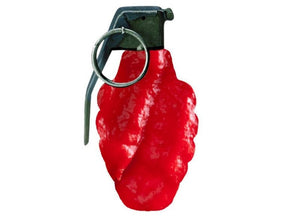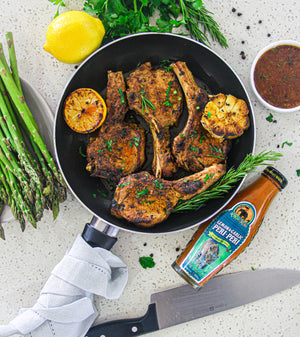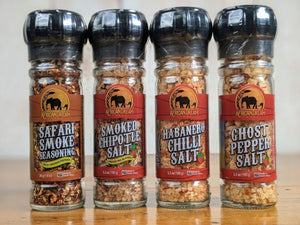How Hot Is Ghost Pepper Sauce Really?
Mar 22, 2022
From habaneros to jalapeños, hot peppers have become a staple in modern cuisine. Not only do they add a kick to our food, but they also have their own distinct flavor.
Now, if you’re a hot pepper enthusiast, then you’ve probably heard of the legendary ghost pepper. Since its introduction to the western world in the 2000s, this bad boy has been in the spotlight for over a decade due to its addictive taste and spiciness. Accordingly, ghost pepper sauces became especially popular with many spice lovers.
Though it was well-known locally, it was an otherwise obscure pepper to the rest of India. However, ghost pepper exploded in popularity, both nationally and Internationally, when in 2000 the Indian Defense Test Laboratory discovered its Scoville rating. The rating was more than double the existing world champion, the Red Savina. Accordingly, ghost pepper sauces became incredibly popular with many spice lovers.
Still, as popular as ghost pepper sauce is, few really know how hot it is. So, let’s dive into the world of ghost peppers and get ready to have your mind blown once you discover the Scoville rating.

What Is Scoville (SHU)?
To truly appreciate how spicy ghost pepper is, you first need to understand what the Scoville scale/Scoville rating is.
Quite simply, the Scoville scale is a way of measuring how hot or spicy a chili pepper is. It was created in 1912 by pharmacist Wilbur Scoville and has been the most popular measurement of spiciness.
Now, as you may already know, capsaicinoids, particularly capsaicin, are the components in chili peppers responsible for the spiciness. This means that the more capsaicin there is in a pepper, the more you’ll feel like a human flamethrower.
That being so, the Scoville scale works by determining just how much capsaicin is present in a chili pepper, giving each pepper an appropriate number of Scoville Heat Units, aka SHU.
How Are Scoville Heat Units Measured?
Thankfully, understanding how the Scoville test works isn’t too complicated.
Basically, you get a chili pepper or hot sauce and see how many times you need to dilute its capsaicin content with a sugar-water solution until you can no longer detect any spiciness or burning sensation. Accordingly, the more you need to dilute a pepper until it’s no longer spicy, the more capsaicin and number of Scoville Heat Units it has.
Now, admittedly, the Scoville test is a bit subjective. Since it mostly depends on the feedback from a panel of humans, things can be a bit inaccurate. That’s because each human palate is unique and varies rather significantly from person to person. So, what one person can perceive as spicy, another may think it’s not.
As such, a different method of heat measurement called high-performance liquid chromatography was invented to eliminate the human variable in the Scoville test.
Nevertheless, to this day, the Scoville scale remains the dominant measurement of spiciness, where it’s widely used by both food lovers and experts all over the world.
How Hot Is Ghost Pepper Sauce?
The ghost pepper sauce Scoville rating is pretty dang astounding. Since many sauces aren’t just made with pure ghost peppers, and either make a ghost pepper brine, add sugar or other aromatics, it’s usually as spicy and as delicious as the actual fruit without the pure heat. So, how spicy are we talking here?
Bhut Jolokia Scoville Rating

Impressively, the Bhut Jolokia Scoville rating can reach up to 1,041,427 SHU. Yup, you read it right. That’s more than a MILLION SHU.
To really prove how spicy that is, look how ghost pepper’s Scoville rating measures up against other peppers and sauces. First off, we’ve got jalapeño peppers with a rating of 2,500 to 8,000 SHU. Next, we have Tabasco sauce at 30,000 to 80,000 SHU and habanero peppers at 100,000 to 350,000 SHU.
This means that ghost pepper is approximately 200 times hotter than a jalapeño, 20 times hotter than Tabasco sauce, and 5-6 times as hot as a habanero.
Of course, the Scoville rating of ghost peppers can slightly vary from one fruit and sauce to another. This is because various factors contribute to the final spiciness, like seed lineage, soil type, humidity levels, ripeness, etc. So, ghost peppers can have a Scoville rating ranging from 855,000 to 1,041,427 SHU.
Proof of Ghost Pepper Spiciness
As you can probably imagine, ghost pepper sauce is not for the weak of heart. In fact, if you’re the type of person who coughs and sputters with a dash of Tabasco sauce, then it’s better you steer clear of anything ghost pepper.
Truly, ghost pepper sauce is for the true spice badasses. In fact, in 2007, Guinness World Records declared that ghost peppers were the spiciest pepper in the world.
They’re so hot that residents of Northern India use them to ward off elephants by smearing the pepper on fences. Did you know that ghost peppers are also used by the Indian military to make non-lethal smoke bombs?

Yup. As weird as it sounds, these chili grenades are actually quite effective at subduing rioters and terrorists. As a matter of fact, these grenades are so irritating and pungent that they were successfully used in 2015 to smoke out a terrorist hiding in a cave.
I mean, hey, the name of this pepper had to come from somewhere, right?
To tell the truth, one time, this pepper almost made an actual ghost from a person.
This happened when a 47-year-old man bit into a burger covered in ghost pepper puree and subsequently started retching and vomiting until he burned a hole in his esophagus. Thankfully though, he was promptly treated and lived to tell the tale. However, the 23-day hospital stay and gastric tube he left with probably made a lasting impact on him.
Bhut Jolokia Vs. Naga Jolokia

Okay, so if you’ve been reading up on Bhut Jolokia (ghost pepper) you may have come across the term Naga Jolokia. So, what exactly is Naga Jolokia, and is it any different from Bhut Jolokia?
To cut a long story short, Naga Jolokia is just another name for our precious ghost pepper.
Bhut Jolokia is cultivated in Bangladesh as well as Northeastern India states, such as Arunachal Pradesh, Nagaland, Assam, and Manipur. Now, each of these places has its own language, and therefore, the nomenclature of ghost pepper greatly varies.
Fortunately, though, the various ghost pepper names aren’t really all that hard to follow. The name Naga Jolokia is after the ferocious warrior tribe of Nagaland. Meanwhile, the people of Assam call ghost pepper Bih Jolokia, aka poison chili, or Bhut Jolokia.
Did you know that many people mistakenly think that the translation of Bhut Jolokia is ghost pepper? Yeah, the Jolokia part meaning pepper is correct. However, Bhut doesn’t actually mean ghost.
The Bhut here means Bhutanese, as in arising from the Bhutan area. However, since the Assamese word for ghost and Bhutanese sound very similar, it was mistranslated. That’s how “ghost pepper” came to be.
It’s worth mentioning that ghost pepper has many other names such as Naga Morich in Bangladesh, Umorok in Manipur, Saga Jolokia, Tezpur chili, Indian Mystery Chili, King Chili, and King Cobra Chili, to name a few.
Are Ghost Peppers the Hottest Chili Peppers Ever?
While ghost peppers were certified to be the spiciest chili peppers in 2007, that is no longer the case. It lost its throne in 2011 when it was superseded by the Infinity Chili.
Following this, several other peppers have appeared to claim their place on the throne, including the Naga Viper, Trinidad Scorpion Butch T, Trinidad Moruga Scorpion, Carolina Reaper, and Dragon’s Breath Chili.
Just for comparison’s sake, Carolina Reaper, the current record-holder of the hottest chili pepper, has a rating of 2.2 million SHU.
This is more than double the ghost pepper Scoville rating of 1 million SHU. So just imagine how painfully hot that is. Honestly, it’s unfathomable how some people can have chili-pepper eating contests using this devilish fruit.
Nevertheless, ghost peppers aren’t to be taken lightly just because Carolina Reapers are off-the-charts hot. They’re still in a league of their own, and your tongue will let you know just how spicy they are.
Ghost Peppers for Health
As scary as we made ghost peppers out, did you know that they are actually great for your health?

Yup, that’s right. Ordinarily, ghost peppers don’t make holes in people’s throats. Sure, it’s spicy, but it’s not to the degree where they can hurt you in moderate amounts. If you’re physically healthy, not only will you enjoy the deliciousness of ghost pepper, but you’ll also greatly benefit from it. So, what makes ghost peppers and their derivatives great for your health? Let’s have a look, shall we?
SEE ALSO: Is Hot Sauce Healthy?
Why Are Ghost Peppers Good for You?
First off, ghost peppers have several vitamins and minerals that are instrumental to your health.
For example, they contain vitamin C, which has various functions in the human body. For one, it plays a role in immunity and wound repair. Moreover, it’s essential for the formation and maintenance of your skin, tendons, and ligaments.
Ghost peppers also contain a multitude of minerals like iron, zinc, phosphorus, and so much more. However, the major reason why ghost peppers are good for you and your health is their capsaicin content.
That’s right. The thing that causes you pain is the thing that brings you the most benefit. Believe it or not, capsaicin is an anti-inflammatory and is great for relieving pain. That’s why it’s used occasionally as a component in topical analgesic creams and lotion.
Additionally, capsaicin has proven to have anti-cancer properties. Not only can it reduce the chance of breast cancer metastasis, but it can also adhere to prostate cancer cells and induce their death.
Impressively, capsaicin can also lower blood glucose and cholesterol levels. So when you combine this with the fact that it can raise your metabolism and improve your mood, it explains why many people who are looking to lose weight are encouraged to eat spicy food, provided they can endure the heat.
On the whole, ghost pepper and ghost pepper sauces are beneficial for your body and your health when used in adequate quantities (as you know even medicine can be poisonous if overdosed). So, try to include some form of ghost peppers in your everyday foods, and your body will greatly thank you for it.
What Will You Experience When You Eat Ghost Pepper?
Here’s a quick rundown about what your body goes through when you take a bite of ghost pepper:
First off, your tongue and other parts of your mouth will start feeling like a house set on fire. That’s because capsaicin binds to the heat and pain receptors of your mouth. This then tells your brain that something damaging is going on. However, despite any pain, you may be feeling at this point, it’s important you know that no actual damage occurs.
Your body will start trying to contain the situation going on in your mouth by trying to cool itself down. Accordingly, you’ll start sweating and panting, and the blood will rush to your face.
You’ll also start tearing up and drooling, in addition to getting an extremely embarrassing runny nose. This happens in order to flush out the capsaicin offenders as fast as possible. You may also get a case of hiccups, but it won’t last for long.
Occasionally, when a chili pepper is hot enough, some people can get diarrhea as a side effect. This occurs as a result of capsaicin pulling lots of water into the intestines. Still, the bout isn’t too awful, so don’t worry too much about it.
Finally, when the peppers are ready to come out the other end, you may experience a slight burning sensation. Just keep in mind that this burning will be much worse if you’ve got hemorrhoids or a similar anal ailment. So, stave off the ghost pepper sauce until you’re feeling better.
SEE ALSO: Can Ghost Pepper Hurt You?
FAQs
Why Are Ghost Peppers So Hot?
Bhut Jolokia has about 3-5% more capsaicin than other chili peppers. While that may not seem like a lot, it actually packs quite a heavy punch. That’s why we greatly recommend you go easy on your ghost pepper portions if you can’t handle your spices.
Who Should Avoid Eating Ghost Pepper Sauce?
Avoid eating ghost peppers if you’re allergic to them or if you’ve got a gastrointestinal problem. So, for example, if you have IBS or a stomach ulcer, you should lay off eating anything spicy. That’s because your symptoms will greatly worsen, though the state of your disease won’t actually change.
What Should You Do if Ghost Pepper Sauce Gets too Hot for You?
If you’re ever feeling overwhelmed when eating ghost peppers or ghost peppers sauce, the first thing you should do is reach out for dairy products, be it a cup of milk or a spoonful of ice cream. If you’re out of dairy products, then chew on some bread, and you’ll have some momentary relief.
Can You Drink Water to Decrease the Burning Sensation?
Well, you can, but we don’t recommend it at all. Water won’t reduce the burning sensation. Rather, it can make it worse by spreading the irritating capsaicin molecules all over your mouth. So it’s best you stick with fat-containing substances such as peanut butter or milk to soothe the burning.
How Long Does the Burning Sensation Last?
On average, it takes about 20-30 minutes for your tongue to return to normal. The burning increase in the first 10-15 minutes, but the heat will gradually ebb away as the capsaicin becomes neutralized and dislodged from your tongue’s pain receptors.
Final Thoughts
Ghost pepper sauce is ridiculously hot due to the significant amount of capsaicin it contains. However, that doesn’t mean it’s not palatable.
People may use ghost peppers to ward off elephants, but they also add flavor to any dish. Moreover, they can drastically improve your mood and have numerous health benefits.
So, if you’ve got a good spice tolerance and you’d like to challenge your limits, then make sure to get yourself a bottle of our very own African Ghost Pepper Sauce. Not only will it knock your socks off, but it’ll have you coming back for more due to its tastiness. And if you’re not sure how to pair your food with ghost pepper sauce, you can always look for inspiration right here.




